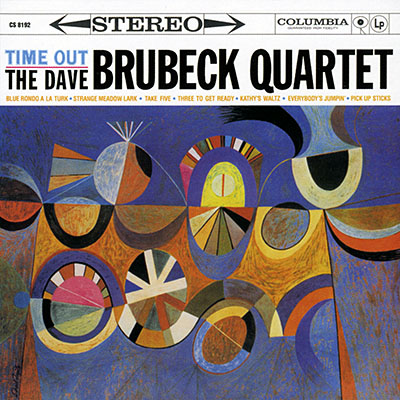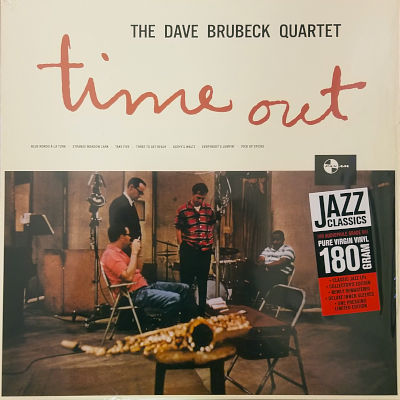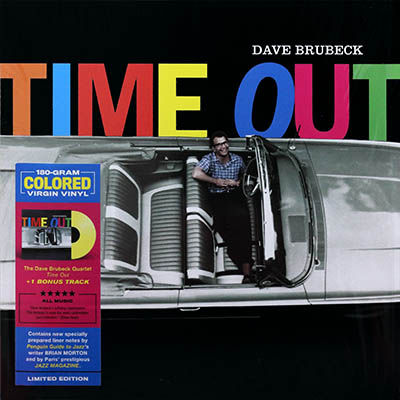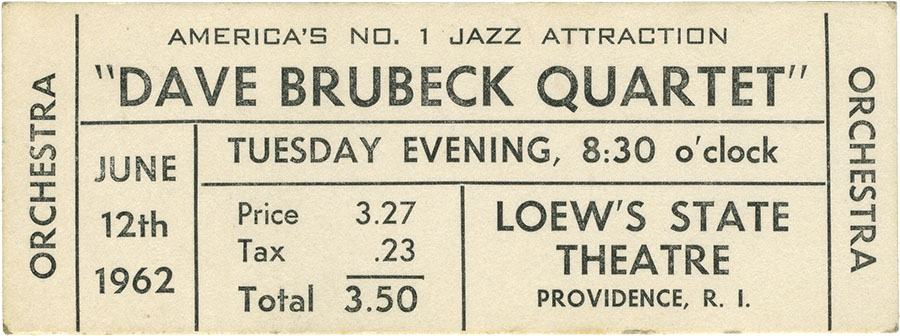


This comparison is unusual in that I compare different vinyl releases of an album, as opposed to comparing vinyl to compact disc or one compact disc release to another. Whereas a case could legitimately be made that such a comparison is likely to be flawed due to the idiosyncracies of different turntables, pickups, and stereo setups, I am here presenting four different releases of the same album spanning a time period of 56 years, played back on the exact same equipment using the exact same setup. The specific releases being used are as follows: 1959 disc - Columbia CS 8192 XSM-47855 / 2010 disc - Jazz Wax Records JWR4525 / 2015 disc - Pan Am 9152247 / 2020 disc - 20th Century Masterworks 350210 on yellow vinyl. All but the 1959 pressing are presented via their very first ever playbacks, and all of the newer discs utilized DMM (Direct Metal Mastering) and 180g virgin vinyl for their production. Obviously, the 1959 disc being reviewed here is not being judged based on its first playback, but I am using the best quality copy I was able to find. If a superior one is ever obtained, I will update the waveforms below (and, if necessary, the analysis). For those in the know, the 1959 disc is from the very first pressing, featuring the "six eyes" Columbia label without "CBS" printed at the top.
Note that the 1959 disc being compared here is the stereo version and not the more common (and arguably superior) mono version from the same year. While the mono mix sounds great, it doesn't make sense to compare it to the stereo mix which has been featured on virtually all releases of this album since the mid-1960s. The mono mix was finally made available on CD in 2016 as part of a deluxe reissue by Green Corner, which features both versions of the album in their entirety as well as two successor Brubeck Quartet albums also featuring experimental time signatures.




























All that having been said, how do these different releases compare? First, some words of explanation: in order to produce a credible and accurate comparison of these four LPs, all four were played back using the exact same equipment and setup for the digital transfer. Additionally, the less common stereo variant of the 1959 LP is being used here, because using the more common mono version in a comparison with three stereo releases would not produce credible results. There's an argument to be made that the mono mix of the album is superior, but that's a discussion for another time. When this album was first recorded and released in 1959, stereo records had only been on the market for a year, and the vast majority of playback sets and equipment in listeners' homes were mono; thus, mono pressings from the first few series of runs are much more common than the stereo variants. Unfortunately, the mono masters were archived once stereo took over the industry, and thus practically all subsequent LP pressings from that point - and eventually CD issues - of Time Out used the stereo mixes. I do have a 1961 mono pressing of Time Out, but it's not being included here. Finally, the evaluation of the 1959 LP is slightly different from its three successors in that I've made allowances for 64 years' worth of age and the fact that, unlike its three companions, it was obviously not a mint condition disc being evaluated on its very first playback. I also made the listening comparisons using headphones instead of my usual speakers because I wanted to be able to hear any fine details that might differentiate the various modern pressings from one another. And now on to the comparisons...
Let me begin by saying that all three audiophile pressings, as far as reproduction of the original recordings goes, sound objectively better than the 1959 original. When I say this I am taking into account the obvious difference in wear between the vintage disc and the audiophile ones. Stereo separation is noticeably better on the newer pressings and overall clarity is definitely better. The bass is particularly stronger on the newer discs when compared to the old. This is to be expected given the differences in raw materials and in the type of masters used. Nevertheless, I do have some issues with two of the modern discs and will begin with the Jazz Wax release. First and foremost, and most egregiously, there's a screechy, dragging-like sound in the background throughout the entire listening experience. While you may not notice it on an average stereo with average speakers, or via a casual or background listen, it is definitely noticeable through headphones or good speakers. The sound is similar to that of a slipping belt in a car engine or wind going through a wind tunnel, and it had to have been introduced somewhere in the mastering or cutting process. This alone is enough to sink the Jazz Wax disc - in jazz, dynamics matter, and hearing this background sound so clearly during the quieter parts of the music is enough to ruin the listening experience. I also see and hear compression in the louder passages, evident most prominently in the album's most famous number, "Take Five." This is a disappointment, given the high end virgin vinyl used and the expectation that - particularly with this kind of material - the mastering would and should have been top notch. Again, a casual listener on casual equipment may not notice, but the discriminating one will, especially when compared to the 1959 disc. Side two of the Jazz Wax record finishes with bonus track "Audrey," a nice little tune, but one which feels thematically out of place compared to the main selections. Thankfully, "Audrey" lacks the compression found across the rest of the disc.
On to the Pan Am disc. This one features not one but two additional bonus tracks, a live version of "Take Five" at the end of side one, and a live version of "Three to Get Ready" which closes out side two. It's also cut at a lower volume level than the Jazz Wax disc, which makes the surface noise a bit louder relative to the music, but the dynamics are noticeably better and the overall sound is much more nuanced. Listen to the busier sections of "Pick Up Sticks" and this will be immediately apparent. The choices made for bonus tracks are good and fit in well with the main album cuts, and the presentation of the added selections is consistent with the main album tracks. Overall, this pressing is solid save for the album art, which inexplicably departs from the original, iconic design.
The final audiophile release being reviewed here is the 20th Century Masterworks edition, released in 2020. Like the Pan Am release, this one aggravatingly eschews the original cover art, replacing it instead with a silly overhead photo of Dave Brubeck lying across the front seat of a convertible. Why? In addition, the album itself is credited to Dave Brubeck, with the rest of the group only highlighted on the back cover, when the album as a whole should be credited to the Dave Brubeck Quartet. The album is pressed on colored vinyl, which I generally understand to be suggestive of potentially reduced sound quality (though this is debated in audiophile circles). I didn't notice anything amiss about the audio capability during my evaluation of the disc, but it does sound less vibrant overall than the Pan Am offering. Dynamics appear to be intact, and selections such as "Take Five" and "Pick Up Sticks" are very well reproduced from that standpoint. The recording level is slightly lower than what's heard on the Pan Am disc, and unfortunately, the overall playback quality is a bit less. On my copy at least, this one seems to suffer somewhat more from occasional pops and clicks than the other two modern pressings do. And to my ear there's something ever so slightly off about the sound of the audio on this offering. On the other two remasters, tape hiss is more noticeable overall than it is on the 1959 original, something which is to be expected given that the higher quality materials and disc mastering would emphasize the analog noise just as they would emphasize the intended recordings. But the tape hiss on the Masterworks edition of this album is noticeably lower when compared to all of the others including the 1959 original. This is apparent right from the beginning of album opener "Blue Rondo à la Turk," and I think the attempt to remove this background noise has colored the overall sound of the audio. To be fair, it's unlikely that the casual listener will notice this, but to me, being so intimately familiar with this album, things sound a bit off. Still, this is subjective, and I'm not going to give too much weight to it in my analysis here. More important are the slightly lower recording level and loss of some vibrancy compared to the Pan Am disc, and the greater number of pops and clicks present in the final product. As with the Jazz Wax edition of Time Out, the sole bonus track on offer is the same 1954 recording of "Audrey," performed by an earlier variation of the Quartet which did not include either Eugene Wright or Joe Morello. It should be noted that here, "Audrey" is presented at a volume level which is more consistent with the rest of the album.
The final ranking of the four editions of Time Out is as follows: [1] Pan-Am Records 180g DMM LP reissue, [2] 20th Century Masterworks colored vinyl 180g DMM LP reissue, [3] 1959 original stereo Columbia LP release, [4] Jazz Wax Records 180g LP reissue. The Jazz Wax variant of the album was easily the biggest disappointment for me, as it's the only one of the reissue discs to feature the original, iconic artwork by S. Neil Fujita on its front cover. Aside from the audio compression, that annoying background noise, that whistling wind tunnel or failing belt in a car engine, mars the enjoyment of the music and is enough of a nuisance that you'll occasionally hear it bleeding through the quieter sections of the album even when not using headphones. These are the only reasons that it loses to the original 1959 disc in this comparison, because it trounces it by all other metrics. I'm also less than impressed that the Masterworks disc is incorrectly credited only to Dave Brubeck instead of to the Dave Brubeck Quartet. One might argue that this is pedantry on full display, but in my opinion it's a very sloppy and annoying oversight. Overall, the Pan Am disc is in my opinion the best choice if you insist on listening to this seminal jazz record off of an actual record.
One final note observation: Even though the sound and clarity of the modern releases is crisp, there's something about the sound of the original pressing that's nevertheless appealing to me. Exactly why this is is hard to articulate here. The acoustics of the listening experience, its very ambience, feels markedly different. It's a lot like idea of comparing the so-called "analog" experience to the so-called "digital" experience that a lot of snooty audiophiles like to claim exists. While I believe this is largely nonsense, it's the best analogy I can come up with to describe the different experiences that come from listening to these discs. The sound of the original pressing just feels a lot less "tight," somehow. And while it won't ever take take the place of my favorite digital copy of this album, the different vibe makes it worth an occasional spin on my turntable on one of those comparatively rare occasions when I feel like playing vinyl.
